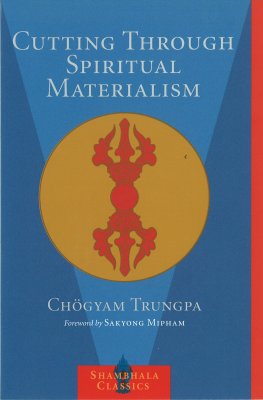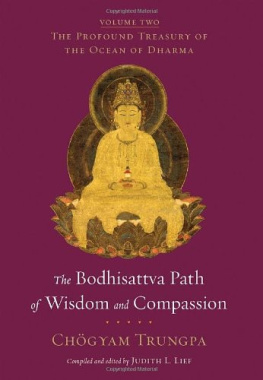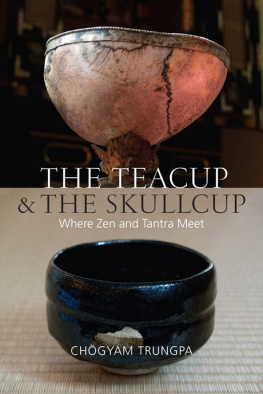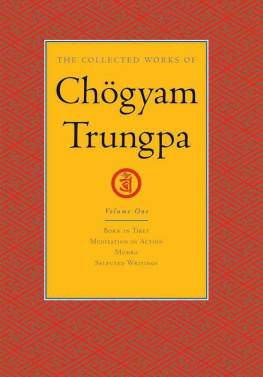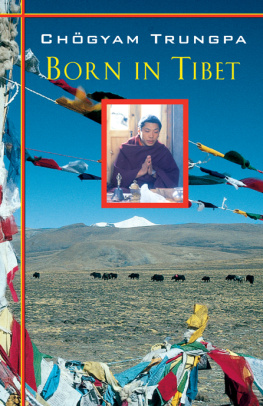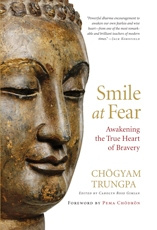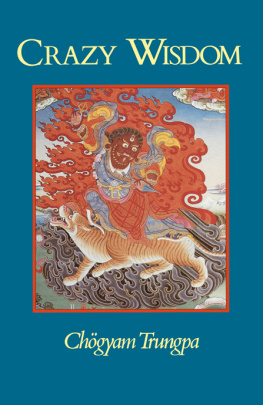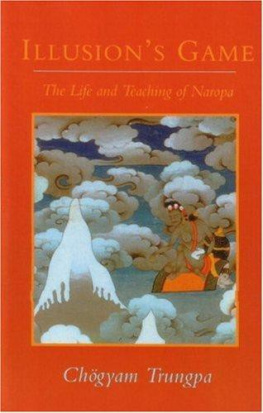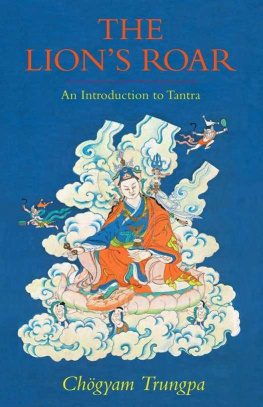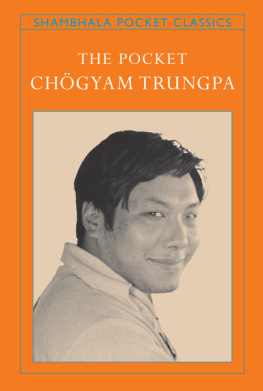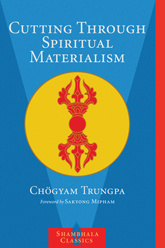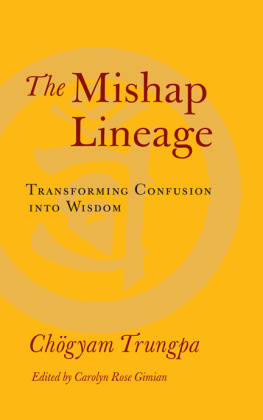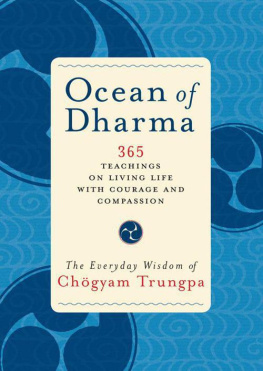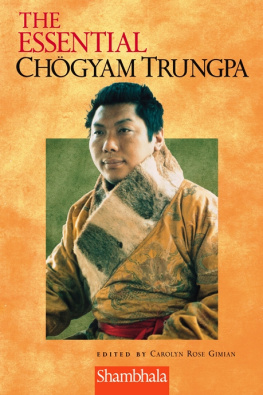Chögyam Trungpa - Cutting Through Spiritual Materialism
Here you can read online Chögyam Trungpa - Cutting Through Spiritual Materialism full text of the book (entire story) in english for free. Download pdf and epub, get meaning, cover and reviews about this ebook. City: Boston & London, year: 2002, publisher: Shambhala Publications, Inc., genre: Religion. Description of the work, (preface) as well as reviews are available. Best literature library LitArk.com created for fans of good reading and offers a wide selection of genres:
Romance novel
Science fiction
Adventure
Detective
Science
History
Home and family
Prose
Art
Politics
Computer
Non-fiction
Religion
Business
Children
Humor
Choose a favorite category and find really read worthwhile books. Enjoy immersion in the world of imagination, feel the emotions of the characters or learn something new for yourself, make an fascinating discovery.
- Book:Cutting Through Spiritual Materialism
- Author:
- Publisher:Shambhala Publications, Inc.
- Genre:
- Year:2002
- City:Boston & London
- ISBN:0-877730504
- Rating:3 / 5
- Favourites:Add to favourites
- Your mark:
- 60
- 1
- 2
- 3
- 4
- 5
Cutting Through Spiritual Materialism: summary, description and annotation
We offer to read an annotation, description, summary or preface (depends on what the author of the book "Cutting Through Spiritual Materialism" wrote himself). If you haven't found the necessary information about the book — write in the comments, we will try to find it.
Cutting Through Spiritual Materialism — read online for free the complete book (whole text) full work
Below is the text of the book, divided by pages. System saving the place of the last page read, allows you to conveniently read the book "Cutting Through Spiritual Materialism" online for free, without having to search again every time where you left off. Put a bookmark, and you can go to the page where you finished reading at any time.
Font size:
Interval:
Bookmark:
To
Chokyi-lodr the Marpa
Father of the Kagy lineage
Foreword
The inspiration to find the truth, to see what is real, and to lead a genuine lifethe culmination of which can be enlightenmentis what underlies every spiritual journey. However, embarking on this journey is rarely as straightforward as we may wish. The journey toward enlightenment ultimately may be both profound and simple, yet the process of understanding that simplicity tends to be multidimensional, if not downright complicated. For in order to understand a spiritual path, we must acknowledge and understand our own mind, now, as it pertains to the journey. What misunderstandings and concepts we may have about a spiritual practice, we must overcome so that were not merely practicing according to our own conceptualized idea. Ego, and the myriad games it plays to unravel our inspiration for enlightenment, must always be monitored.
To understand the essential qualities of the spiritual path, especially what obstacles or conundrums might lie ahead, we need a clear sense of direction. We need teachings, instructions, and guidance from someone who has traveled the path and therefore can give valid and confident advice about how others could travel this same path. This is what is offered by my father, Chgyam Trungpa, in Cutting through Spiritual Materialism.
These lectures and teachings were given in the early 1970s, at a crossroads of heightened awareness and spiritual awakening in the United States. East was beginning to meet West. Having turned away from their parents values, a whole generation was investigating newly available spiritual pathsmany of them quite traditional. People wanted a path that would help them rise above lifes mundane trappings to see a more expansive view, a view that would dissolve their feeling of alienation and penetrate lifes very meaning. At the same time, many of these seekers were still trying to figure out what a genuine path to liberation was. There was a quality of freshness, exuberance, excitement, and youth, as well as naivet.
People were naive about the many pitfalls possible on any path. Spiritual awakening is not a happy-go-lucky endeavor. The path of truth is profoundand so are the obstacles and possibilities for self-deception. No matter what the practice or teaching, ego loves to wait in ambush to appropriate spirituality for its own survival and gain. Chgyam Trungpawho had just arrived in the States from Scotlandtried to clarify these issues. He wanted to raise peoples awareness to a level where they could distinguish between what is genuine spiritual progress and what is ego hijacking spirituality for its own purposes. He wanted to help them learn to recognize the grip of the Three Lords of Materialismstrategies that ego can use any time, any place, in order to seduce us from a bigger view back into its self-limiting perspective.
From an early age, Chgyam Trungpa had undergone an arduous education in the monasteries of Kham, on the high plateau of Tibets eastern region. Even the medieval culture of Tibet was not immune to the perils of spiritual materialism. His teachers had trained him in recognizing the wiliness of ego and in avoiding seduction into seemingly beneficial activities that are really just mundane material pursuits in sacred garments. Here was a teacher who clearly understood the materialistic dilemma of the spiritual path, one who had been steeped and trained in the ancient wisdom of the pastand who could also understand the nuances of modern-day Western-style spiritual blockage. The teachings in this book represent a milestone in the introduction of buddhadharma into American culture.
In part because of the playfulness with which my father taught his young American students, Cutting Through Spiritual Materialism has become a classic. For those in the audience who were experimenting with rejecting society in order to pursue an idealistic, transcendental path, his teachings shed new light on working with themselves in the context of their own country, family, and culture. As an enthusiastic newcomer to the West and a spiritual elder as well, he was able to introduce to them the basic workability of their own situation as part of the spiritual path. Rejecting everything was not the solution. Training ones mind, body, and speech in accordance with the truth would bring about the understanding and wisdom that produces peace. Many of those students followed his advice, continuing on their spiritual journeys and at the same time becoming parents, teachers, business people, and even dharma teachers. These people have now become the elders for a new generation of inquisitive minds.
Even though the message of this book was addressed to a particular group at a particular time in history, it is not only for that generation. These teachings will never be dated or pigeonholed. In the last thirty years, in our continuing pursuit of whatever will distract us from the truth of pain and suffering, we have become even more materialistic. In the spiritual realm, there are now even more paths and possibilities to explore than when this book was first publishednot just the classic spiritual disciplines, but also many hybrids. This book continues to have the power to sharpen our awareness of spiritual materialism. It deserves our careful attention, as its message is more applicable now than ever.
Sakyong Mipham RinpocheOctober 2001CUTTING THROUGH SPIRITUAL MATERIALISM
Introduction
The following series of talks was given in Boulder, Colorado in the fall of 1970 and the spring of 1971. At that time we were just forming Karma Dzong, our meditation center in Boulder. Although most of my students were sincere in their aspiration to walk on the spiritual path, they brought to it a great deal of confusion, misunderstanding and expectation. Therefore, I found it necessary to present to my students an overview of the path and some warnings as to the dangers along that path.
It now seems that publishing these talks may be helpful to those who have become interested in spiritual disciplines. Walking the spiritual path properly is a very subtle process; it is not something to jump into naively. There are numerous sidetracks which lead to a distorted, ego-centered version of spirituality; we can deceive ourselves into thinking we are developing spiritually when instead we are strengthening our egocentricity through spiritual techniques. This fundamental distortion may be referred to as spiritual materialism.
These talks first discuss the various ways in which people involve themselves with spiritual materialism, the many forms of self-deception into which aspirants may fall. After this tour of the sidetracks along the way, we discuss the broad outlines of the true spiritual path.
The approach presented here is a classical Buddhist onenot in a formal sense, but in the sense of presenting the heart of the Buddhist approach to spirituality. Although the Buddhist way is not theistic, it does not contradict the theistic disciplines. Rather the differences between the ways are a matter of emphasis and method. The basic problems of spiritual materialism are common to all spiritual disciplines. The Buddhist approach begins with our confusion and suffering and works toward the unraveling of their origin. The theistic approach begins with the richness of God and works toward raising consciousness so as to experience Gods presence. But since the obstacles to relating with God are our confusions and negativities, the theistic approach must also deal with them. Spiritual pride, for example, is as much a problem in theistic disciplines as in Buddhism.
According to the Buddhist tradition, the spiritual path is the process of cutting through our confusion, of uncovering the awakened state of mind. When the awakened state of mind is crowded in by ego and its attendant paranoia, it takes on the character of an underlying instinct. So it is not a matter of building up the awakened state of mind, but rather of burning out the confusions which obstruct it. In the process of burning out these confusions, we discover enlightenment. If the process were otherwise, the awakened state of mind would be a product, dependent upon cause and effect and therefore liable to dissolution. Anything which is created must, sooner or later, die. If enlightenment were created in such a way, there would always be the possibility of ego reasserting itself, causing a return to the confused state. Enlightenment is permanent because we have not produced it; we have merely discovered it. In the Buddhist tradition the analogy of the sun appearing from behind the clouds is often used to explain the discovery of enlightenment. In meditation practice we clear away the confusion of ego in order to glimpse the awakened state. The absence of ignorance, of being crowded in, of paranoia, opens up a tremendous view of life. One discovers a different way of being.
Font size:
Interval:
Bookmark:
Similar books «Cutting Through Spiritual Materialism»
Look at similar books to Cutting Through Spiritual Materialism. We have selected literature similar in name and meaning in the hope of providing readers with more options to find new, interesting, not yet read works.
Discussion, reviews of the book Cutting Through Spiritual Materialism and just readers' own opinions. Leave your comments, write what you think about the work, its meaning or the main characters. Specify what exactly you liked and what you didn't like, and why you think so.

